Business Decision Making - Horseshoe Resort
VerifiedAdded on 2022/08/12
|9
|1659
|15
AI Summary
Contribute Materials
Your contribution can guide someone’s learning journey. Share your
documents today.
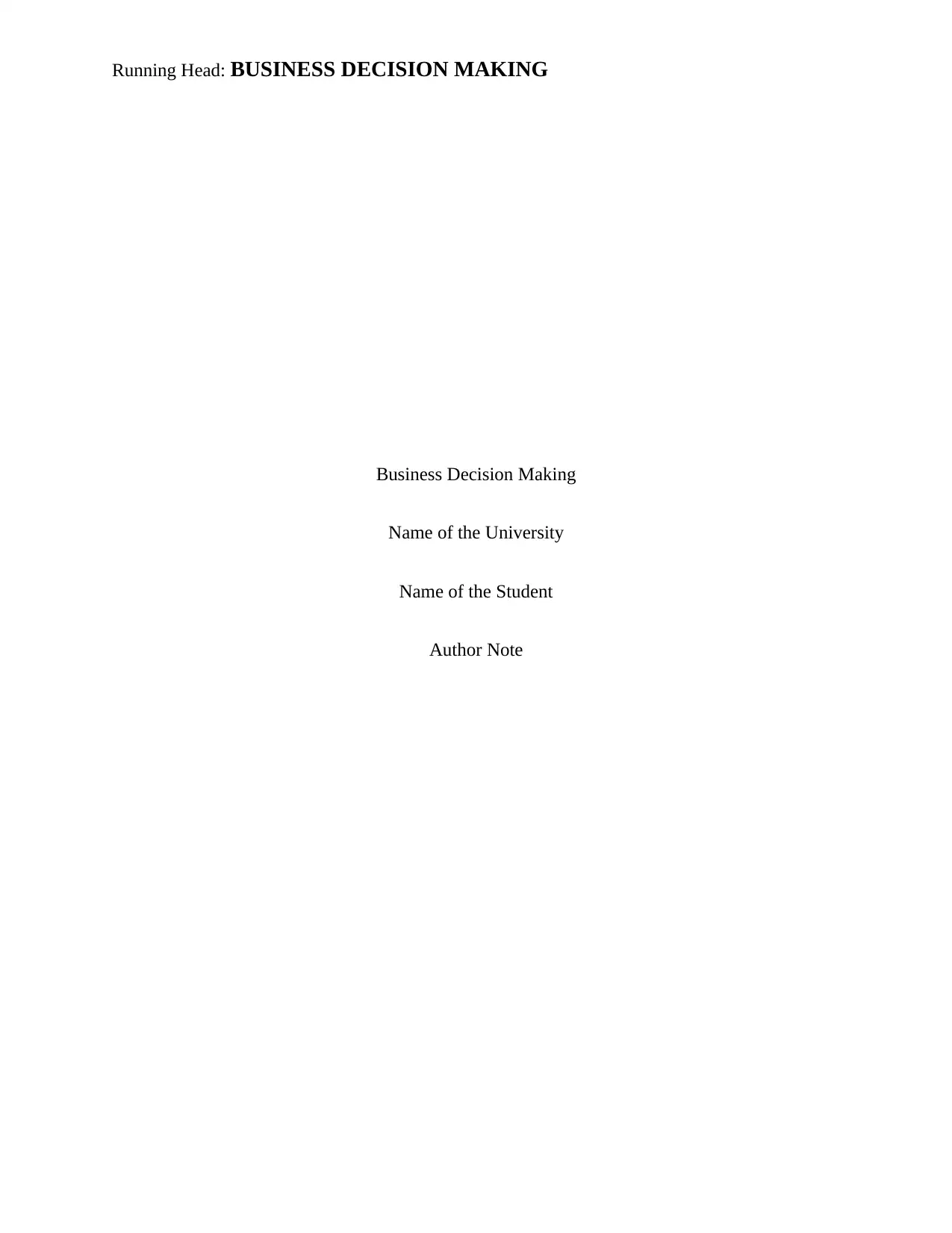
Running Head: BUSINESS DECISION MAKING
Business Decision Making
Name of the University
Name of the Student
Author Note
Business Decision Making
Name of the University
Name of the Student
Author Note
Secure Best Marks with AI Grader
Need help grading? Try our AI Grader for instant feedback on your assignments.
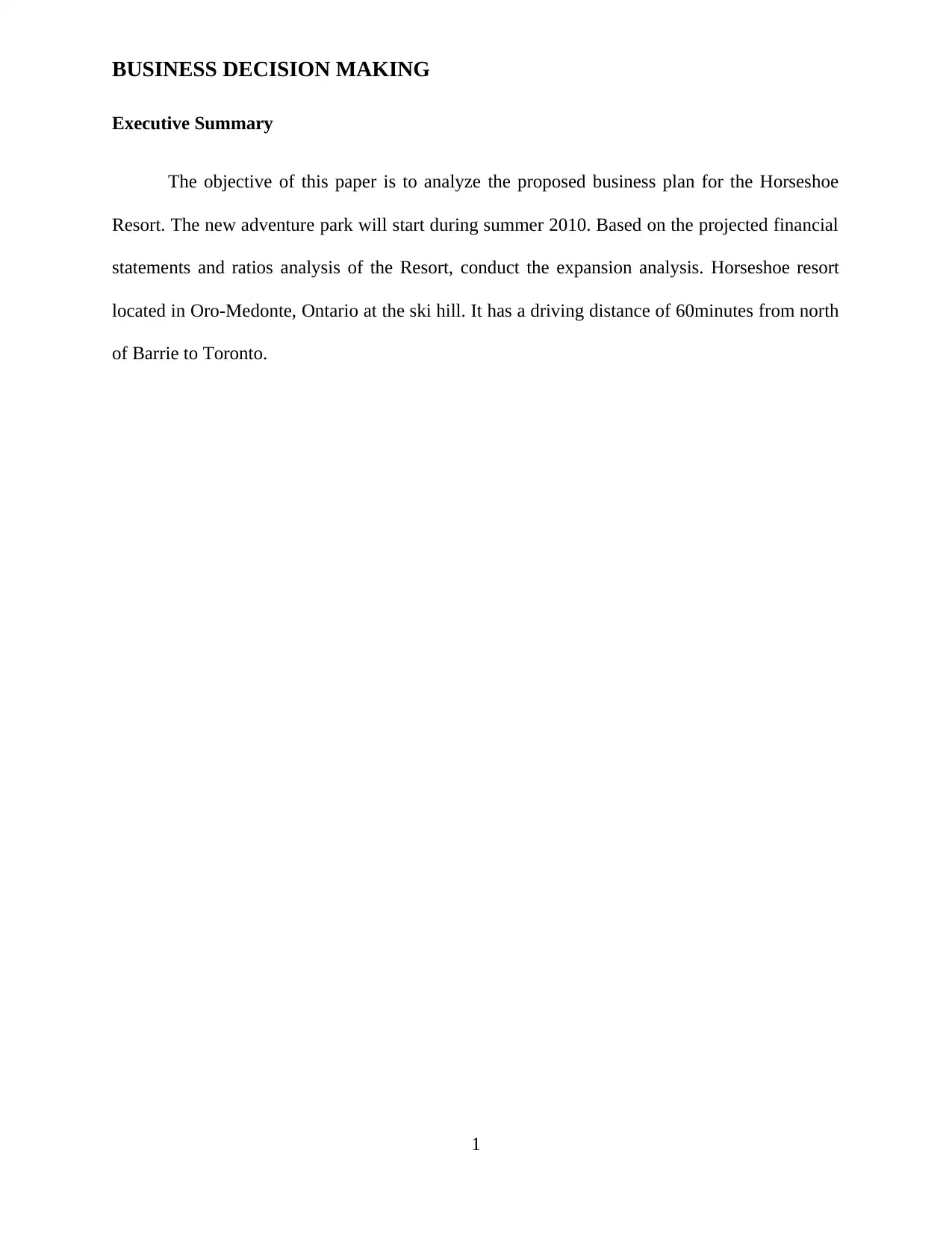
BUSINESS DECISION MAKING
Executive Summary
The objective of this paper is to analyze the proposed business plan for the Horseshoe
Resort. The new adventure park will start during summer 2010. Based on the projected financial
statements and ratios analysis of the Resort, conduct the expansion analysis. Horseshoe resort
located in Oro-Medonte, Ontario at the ski hill. It has a driving distance of 60minutes from north
of Barrie to Toronto.
1
Executive Summary
The objective of this paper is to analyze the proposed business plan for the Horseshoe
Resort. The new adventure park will start during summer 2010. Based on the projected financial
statements and ratios analysis of the Resort, conduct the expansion analysis. Horseshoe resort
located in Oro-Medonte, Ontario at the ski hill. It has a driving distance of 60minutes from north
of Barrie to Toronto.
1
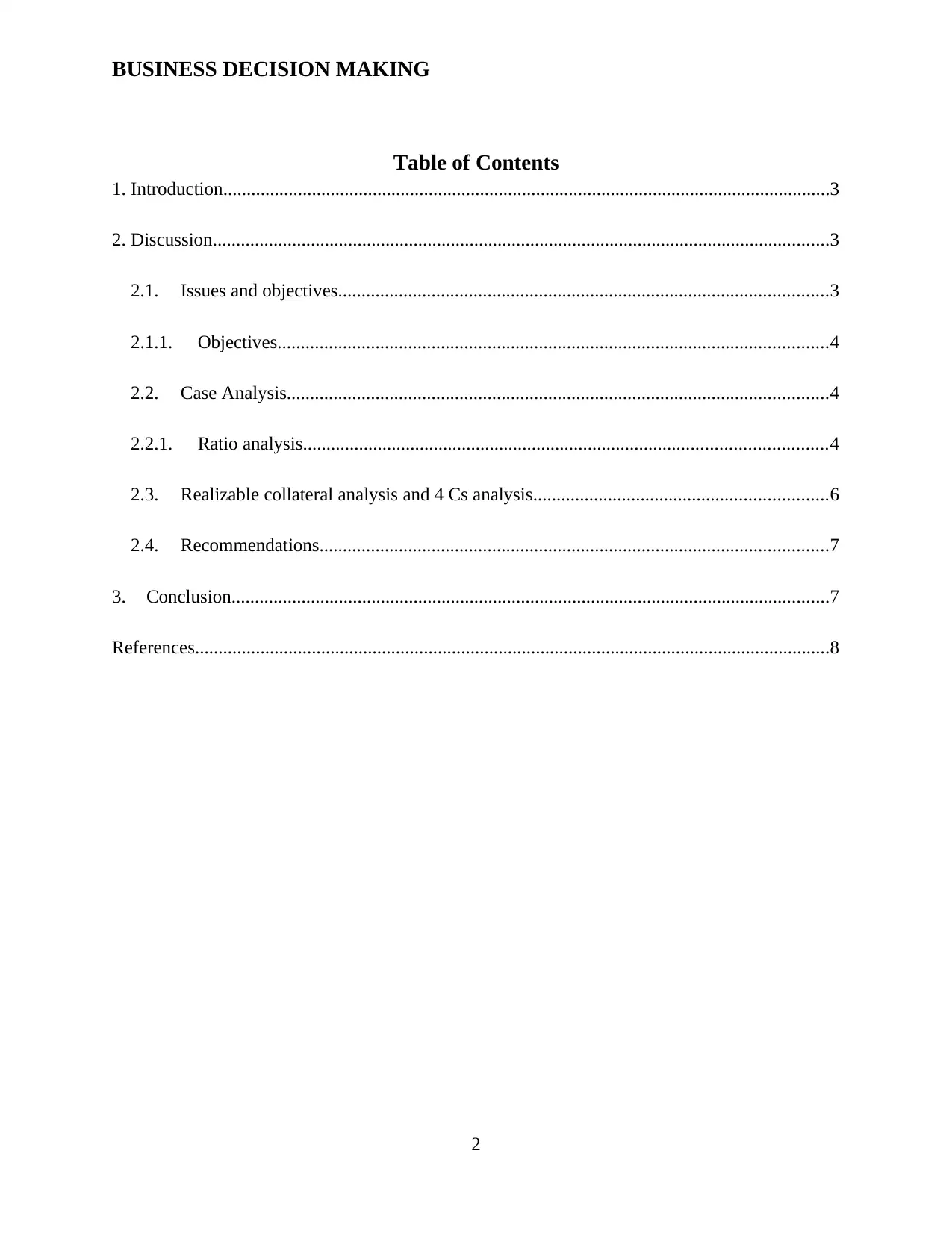
BUSINESS DECISION MAKING
Table of Contents
1. Introduction..................................................................................................................................3
2. Discussion....................................................................................................................................3
2.1. Issues and objectives.........................................................................................................3
2.1.1. Objectives......................................................................................................................4
2.2. Case Analysis....................................................................................................................4
2.2.1. Ratio analysis................................................................................................................4
2.3. Realizable collateral analysis and 4 Cs analysis...............................................................6
2.4. Recommendations.............................................................................................................7
3. Conclusion................................................................................................................................7
References........................................................................................................................................8
2
Table of Contents
1. Introduction..................................................................................................................................3
2. Discussion....................................................................................................................................3
2.1. Issues and objectives.........................................................................................................3
2.1.1. Objectives......................................................................................................................4
2.2. Case Analysis....................................................................................................................4
2.2.1. Ratio analysis................................................................................................................4
2.3. Realizable collateral analysis and 4 Cs analysis...............................................................6
2.4. Recommendations.............................................................................................................7
3. Conclusion................................................................................................................................7
References........................................................................................................................................8
2
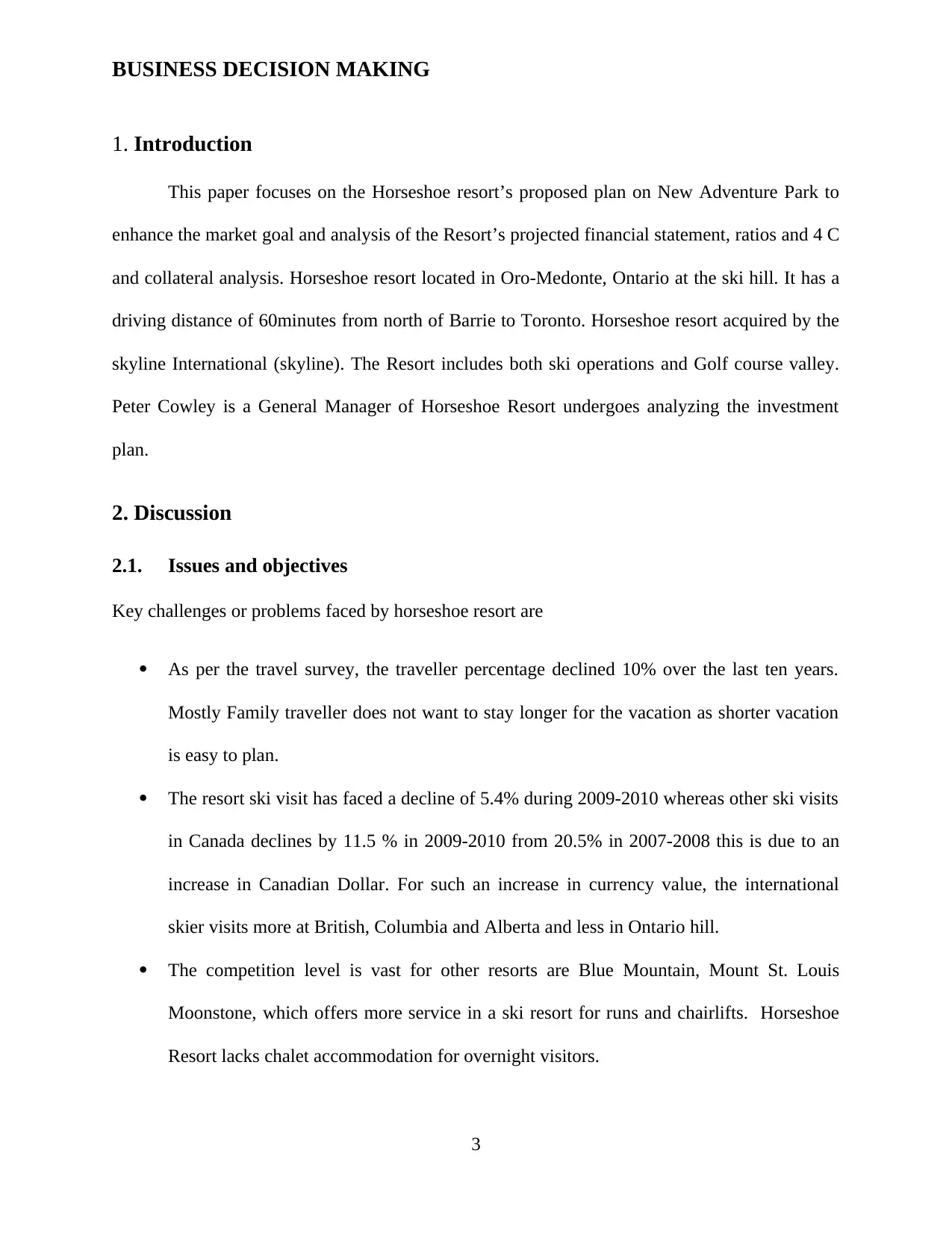
BUSINESS DECISION MAKING
1. Introduction
This paper focuses on the Horseshoe resort’s proposed plan on New Adventure Park to
enhance the market goal and analysis of the Resort’s projected financial statement, ratios and 4 C
and collateral analysis. Horseshoe resort located in Oro-Medonte, Ontario at the ski hill. It has a
driving distance of 60minutes from north of Barrie to Toronto. Horseshoe resort acquired by the
skyline International (skyline). The Resort includes both ski operations and Golf course valley.
Peter Cowley is a General Manager of Horseshoe Resort undergoes analyzing the investment
plan.
2. Discussion
2.1. Issues and objectives
Key challenges or problems faced by horseshoe resort are
As per the travel survey, the traveller percentage declined 10% over the last ten years.
Mostly Family traveller does not want to stay longer for the vacation as shorter vacation
is easy to plan.
The resort ski visit has faced a decline of 5.4% during 2009-2010 whereas other ski visits
in Canada declines by 11.5 % in 2009-2010 from 20.5% in 2007-2008 this is due to an
increase in Canadian Dollar. For such an increase in currency value, the international
skier visits more at British, Columbia and Alberta and less in Ontario hill.
The competition level is vast for other resorts are Blue Mountain, Mount St. Louis
Moonstone, which offers more service in a ski resort for runs and chairlifts. Horseshoe
Resort lacks chalet accommodation for overnight visitors.
3
1. Introduction
This paper focuses on the Horseshoe resort’s proposed plan on New Adventure Park to
enhance the market goal and analysis of the Resort’s projected financial statement, ratios and 4 C
and collateral analysis. Horseshoe resort located in Oro-Medonte, Ontario at the ski hill. It has a
driving distance of 60minutes from north of Barrie to Toronto. Horseshoe resort acquired by the
skyline International (skyline). The Resort includes both ski operations and Golf course valley.
Peter Cowley is a General Manager of Horseshoe Resort undergoes analyzing the investment
plan.
2. Discussion
2.1. Issues and objectives
Key challenges or problems faced by horseshoe resort are
As per the travel survey, the traveller percentage declined 10% over the last ten years.
Mostly Family traveller does not want to stay longer for the vacation as shorter vacation
is easy to plan.
The resort ski visit has faced a decline of 5.4% during 2009-2010 whereas other ski visits
in Canada declines by 11.5 % in 2009-2010 from 20.5% in 2007-2008 this is due to an
increase in Canadian Dollar. For such an increase in currency value, the international
skier visits more at British, Columbia and Alberta and less in Ontario hill.
The competition level is vast for other resorts are Blue Mountain, Mount St. Louis
Moonstone, which offers more service in a ski resort for runs and chairlifts. Horseshoe
Resort lacks chalet accommodation for overnight visitors.
3
Secure Best Marks with AI Grader
Need help grading? Try our AI Grader for instant feedback on your assignments.
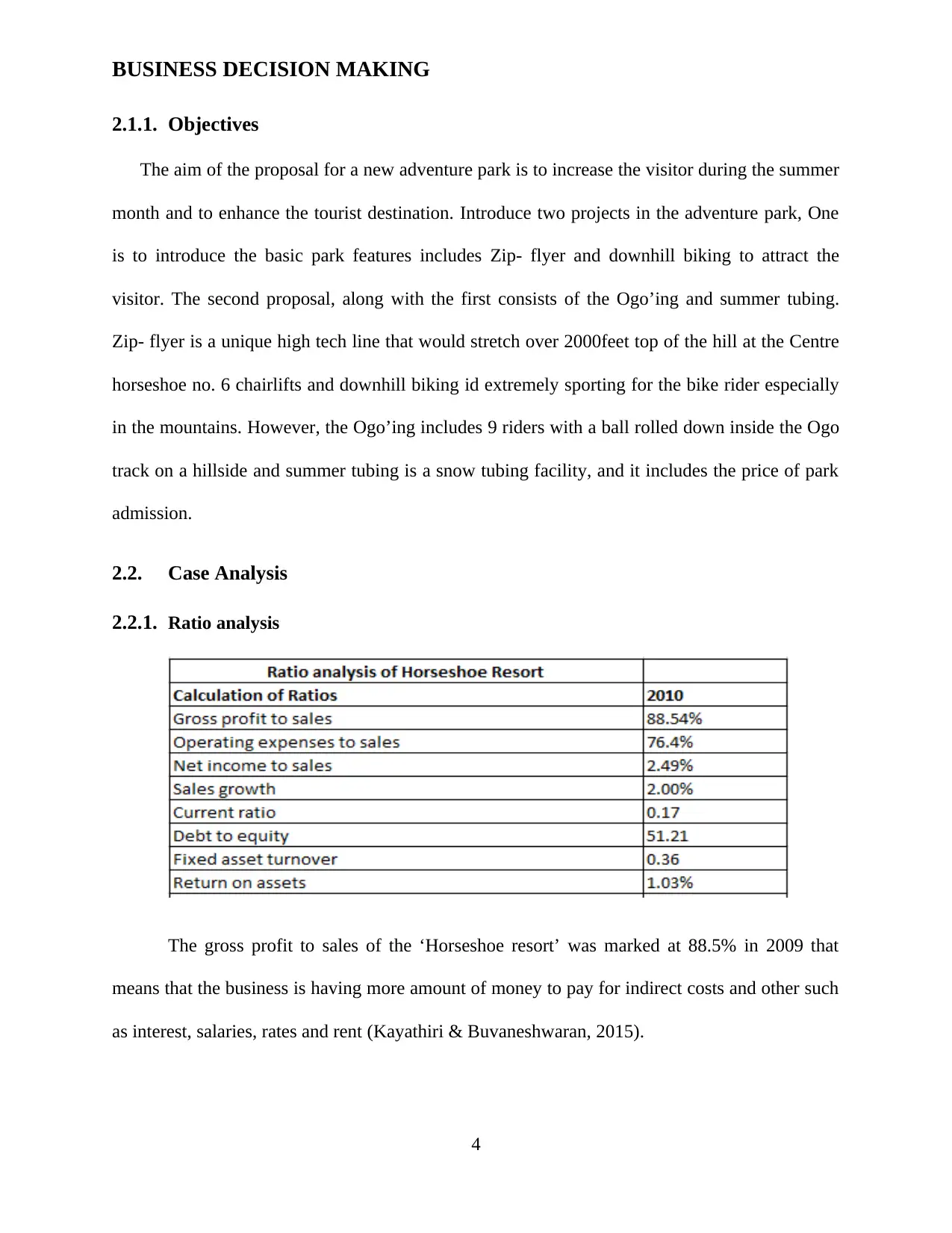
BUSINESS DECISION MAKING
2.1.1. Objectives
The aim of the proposal for a new adventure park is to increase the visitor during the summer
month and to enhance the tourist destination. Introduce two projects in the adventure park, One
is to introduce the basic park features includes Zip- flyer and downhill biking to attract the
visitor. The second proposal, along with the first consists of the Ogo’ing and summer tubing.
Zip- flyer is a unique high tech line that would stretch over 2000feet top of the hill at the Centre
horseshoe no. 6 chairlifts and downhill biking id extremely sporting for the bike rider especially
in the mountains. However, the Ogo’ing includes 9 riders with a ball rolled down inside the Ogo
track on a hillside and summer tubing is a snow tubing facility, and it includes the price of park
admission.
2.2. Case Analysis
2.2.1. Ratio analysis
The gross profit to sales of the ‘Horseshoe resort’ was marked at 88.5% in 2009 that
means that the business is having more amount of money to pay for indirect costs and other such
as interest, salaries, rates and rent (Kayathiri & Buvaneshwaran, 2015).
4
2.1.1. Objectives
The aim of the proposal for a new adventure park is to increase the visitor during the summer
month and to enhance the tourist destination. Introduce two projects in the adventure park, One
is to introduce the basic park features includes Zip- flyer and downhill biking to attract the
visitor. The second proposal, along with the first consists of the Ogo’ing and summer tubing.
Zip- flyer is a unique high tech line that would stretch over 2000feet top of the hill at the Centre
horseshoe no. 6 chairlifts and downhill biking id extremely sporting for the bike rider especially
in the mountains. However, the Ogo’ing includes 9 riders with a ball rolled down inside the Ogo
track on a hillside and summer tubing is a snow tubing facility, and it includes the price of park
admission.
2.2. Case Analysis
2.2.1. Ratio analysis
The gross profit to sales of the ‘Horseshoe resort’ was marked at 88.5% in 2009 that
means that the business is having more amount of money to pay for indirect costs and other such
as interest, salaries, rates and rent (Kayathiri & Buvaneshwaran, 2015).
4
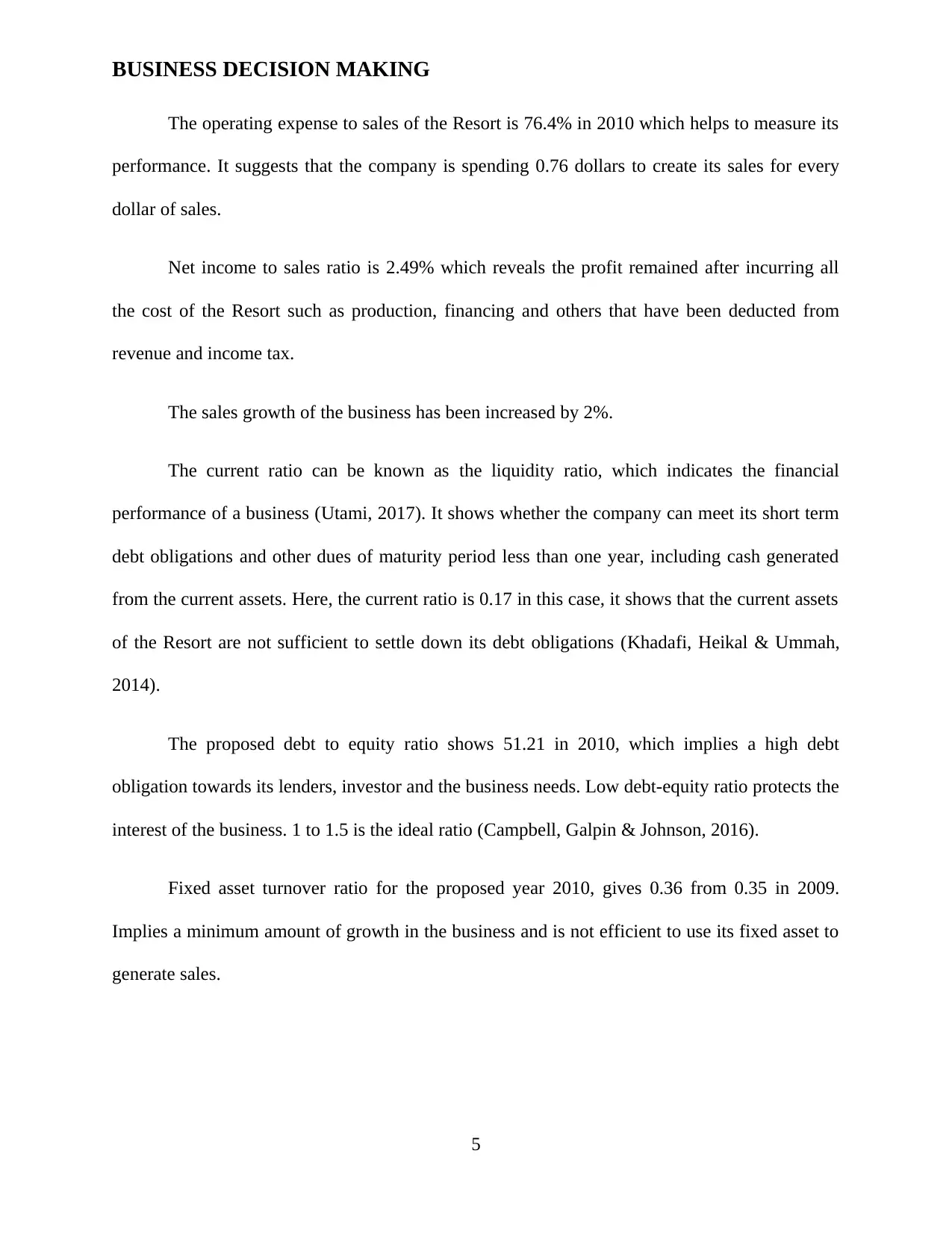
BUSINESS DECISION MAKING
The operating expense to sales of the Resort is 76.4% in 2010 which helps to measure its
performance. It suggests that the company is spending 0.76 dollars to create its sales for every
dollar of sales.
Net income to sales ratio is 2.49% which reveals the profit remained after incurring all
the cost of the Resort such as production, financing and others that have been deducted from
revenue and income tax.
The sales growth of the business has been increased by 2%.
The current ratio can be known as the liquidity ratio, which indicates the financial
performance of a business (Utami, 2017). It shows whether the company can meet its short term
debt obligations and other dues of maturity period less than one year, including cash generated
from the current assets. Here, the current ratio is 0.17 in this case, it shows that the current assets
of the Resort are not sufficient to settle down its debt obligations (Khadafi, Heikal & Ummah,
2014).
The proposed debt to equity ratio shows 51.21 in 2010, which implies a high debt
obligation towards its lenders, investor and the business needs. Low debt-equity ratio protects the
interest of the business. 1 to 1.5 is the ideal ratio (Campbell, Galpin & Johnson, 2016).
Fixed asset turnover ratio for the proposed year 2010, gives 0.36 from 0.35 in 2009.
Implies a minimum amount of growth in the business and is not efficient to use its fixed asset to
generate sales.
5
The operating expense to sales of the Resort is 76.4% in 2010 which helps to measure its
performance. It suggests that the company is spending 0.76 dollars to create its sales for every
dollar of sales.
Net income to sales ratio is 2.49% which reveals the profit remained after incurring all
the cost of the Resort such as production, financing and others that have been deducted from
revenue and income tax.
The sales growth of the business has been increased by 2%.
The current ratio can be known as the liquidity ratio, which indicates the financial
performance of a business (Utami, 2017). It shows whether the company can meet its short term
debt obligations and other dues of maturity period less than one year, including cash generated
from the current assets. Here, the current ratio is 0.17 in this case, it shows that the current assets
of the Resort are not sufficient to settle down its debt obligations (Khadafi, Heikal & Ummah,
2014).
The proposed debt to equity ratio shows 51.21 in 2010, which implies a high debt
obligation towards its lenders, investor and the business needs. Low debt-equity ratio protects the
interest of the business. 1 to 1.5 is the ideal ratio (Campbell, Galpin & Johnson, 2016).
Fixed asset turnover ratio for the proposed year 2010, gives 0.36 from 0.35 in 2009.
Implies a minimum amount of growth in the business and is not efficient to use its fixed asset to
generate sales.
5
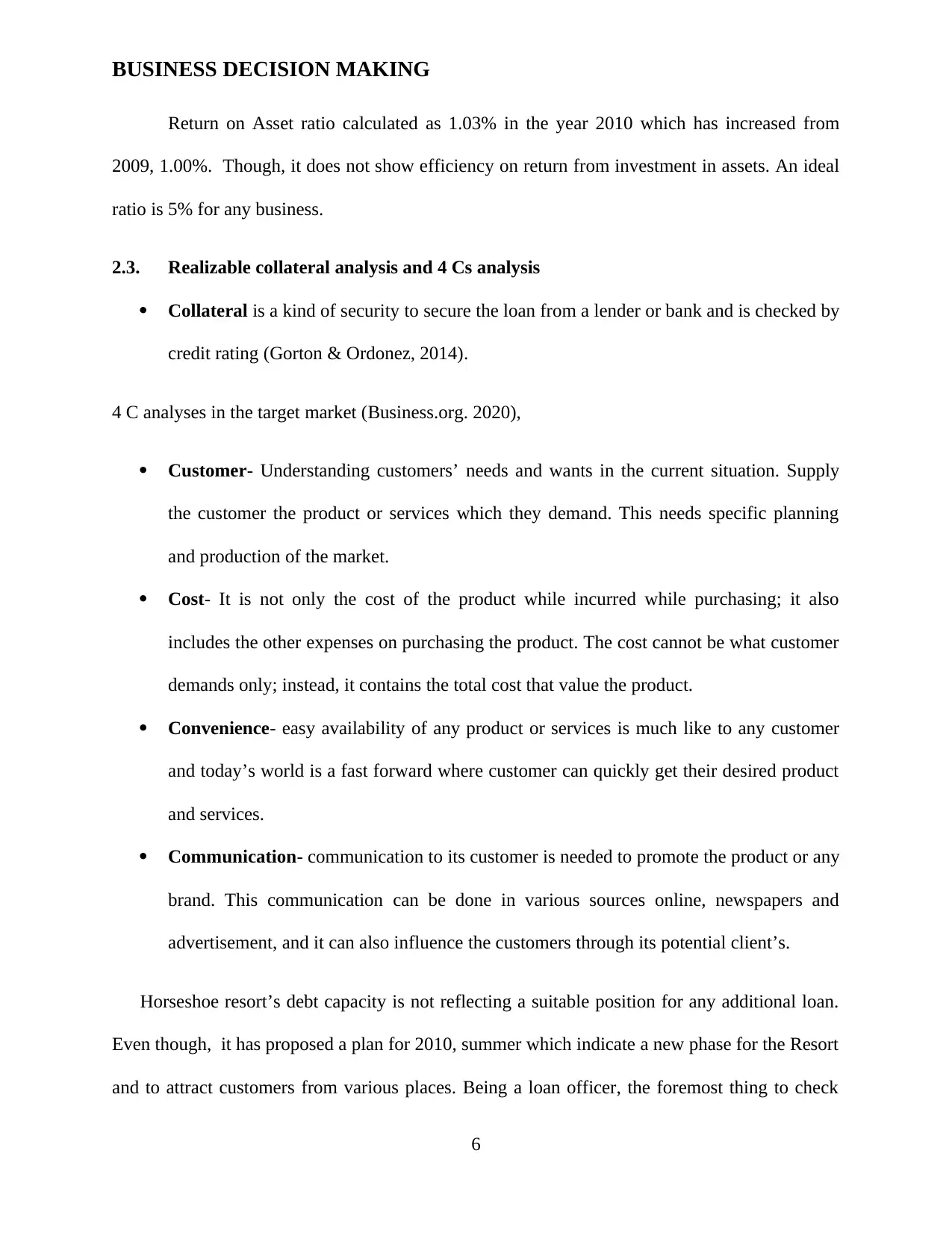
BUSINESS DECISION MAKING
Return on Asset ratio calculated as 1.03% in the year 2010 which has increased from
2009, 1.00%. Though, it does not show efficiency on return from investment in assets. An ideal
ratio is 5% for any business.
2.3. Realizable collateral analysis and 4 Cs analysis
Collateral is a kind of security to secure the loan from a lender or bank and is checked by
credit rating (Gorton & Ordonez, 2014).
4 C analyses in the target market (Business.org. 2020),
Customer- Understanding customers’ needs and wants in the current situation. Supply
the customer the product or services which they demand. This needs specific planning
and production of the market.
Cost- It is not only the cost of the product while incurred while purchasing; it also
includes the other expenses on purchasing the product. The cost cannot be what customer
demands only; instead, it contains the total cost that value the product.
Convenience- easy availability of any product or services is much like to any customer
and today’s world is a fast forward where customer can quickly get their desired product
and services.
Communication- communication to its customer is needed to promote the product or any
brand. This communication can be done in various sources online, newspapers and
advertisement, and it can also influence the customers through its potential client’s.
Horseshoe resort’s debt capacity is not reflecting a suitable position for any additional loan.
Even though, it has proposed a plan for 2010, summer which indicate a new phase for the Resort
and to attract customers from various places. Being a loan officer, the foremost thing to check
6
Return on Asset ratio calculated as 1.03% in the year 2010 which has increased from
2009, 1.00%. Though, it does not show efficiency on return from investment in assets. An ideal
ratio is 5% for any business.
2.3. Realizable collateral analysis and 4 Cs analysis
Collateral is a kind of security to secure the loan from a lender or bank and is checked by
credit rating (Gorton & Ordonez, 2014).
4 C analyses in the target market (Business.org. 2020),
Customer- Understanding customers’ needs and wants in the current situation. Supply
the customer the product or services which they demand. This needs specific planning
and production of the market.
Cost- It is not only the cost of the product while incurred while purchasing; it also
includes the other expenses on purchasing the product. The cost cannot be what customer
demands only; instead, it contains the total cost that value the product.
Convenience- easy availability of any product or services is much like to any customer
and today’s world is a fast forward where customer can quickly get their desired product
and services.
Communication- communication to its customer is needed to promote the product or any
brand. This communication can be done in various sources online, newspapers and
advertisement, and it can also influence the customers through its potential client’s.
Horseshoe resort’s debt capacity is not reflecting a suitable position for any additional loan.
Even though, it has proposed a plan for 2010, summer which indicate a new phase for the Resort
and to attract customers from various places. Being a loan officer, the foremost thing to check
6
Paraphrase This Document
Need a fresh take? Get an instant paraphrase of this document with our AI Paraphraser
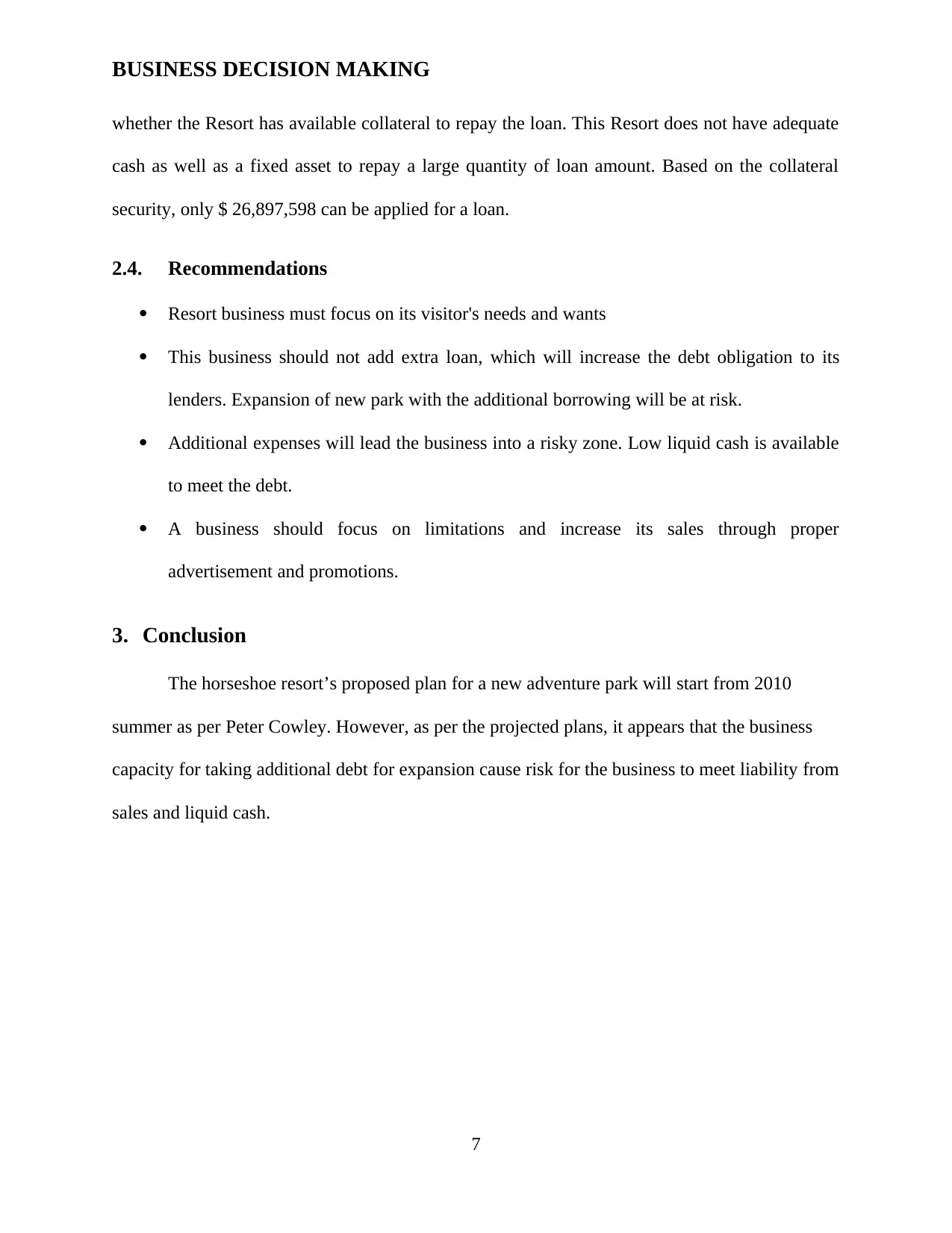
BUSINESS DECISION MAKING
whether the Resort has available collateral to repay the loan. This Resort does not have adequate
cash as well as a fixed asset to repay a large quantity of loan amount. Based on the collateral
security, only $ 26,897,598 can be applied for a loan.
2.4. Recommendations
Resort business must focus on its visitor's needs and wants
This business should not add extra loan, which will increase the debt obligation to its
lenders. Expansion of new park with the additional borrowing will be at risk.
Additional expenses will lead the business into a risky zone. Low liquid cash is available
to meet the debt.
A business should focus on limitations and increase its sales through proper
advertisement and promotions.
3. Conclusion
The horseshoe resort’s proposed plan for a new adventure park will start from 2010
summer as per Peter Cowley. However, as per the projected plans, it appears that the business
capacity for taking additional debt for expansion cause risk for the business to meet liability from
sales and liquid cash.
7
whether the Resort has available collateral to repay the loan. This Resort does not have adequate
cash as well as a fixed asset to repay a large quantity of loan amount. Based on the collateral
security, only $ 26,897,598 can be applied for a loan.
2.4. Recommendations
Resort business must focus on its visitor's needs and wants
This business should not add extra loan, which will increase the debt obligation to its
lenders. Expansion of new park with the additional borrowing will be at risk.
Additional expenses will lead the business into a risky zone. Low liquid cash is available
to meet the debt.
A business should focus on limitations and increase its sales through proper
advertisement and promotions.
3. Conclusion
The horseshoe resort’s proposed plan for a new adventure park will start from 2010
summer as per Peter Cowley. However, as per the projected plans, it appears that the business
capacity for taking additional debt for expansion cause risk for the business to meet liability from
sales and liquid cash.
7
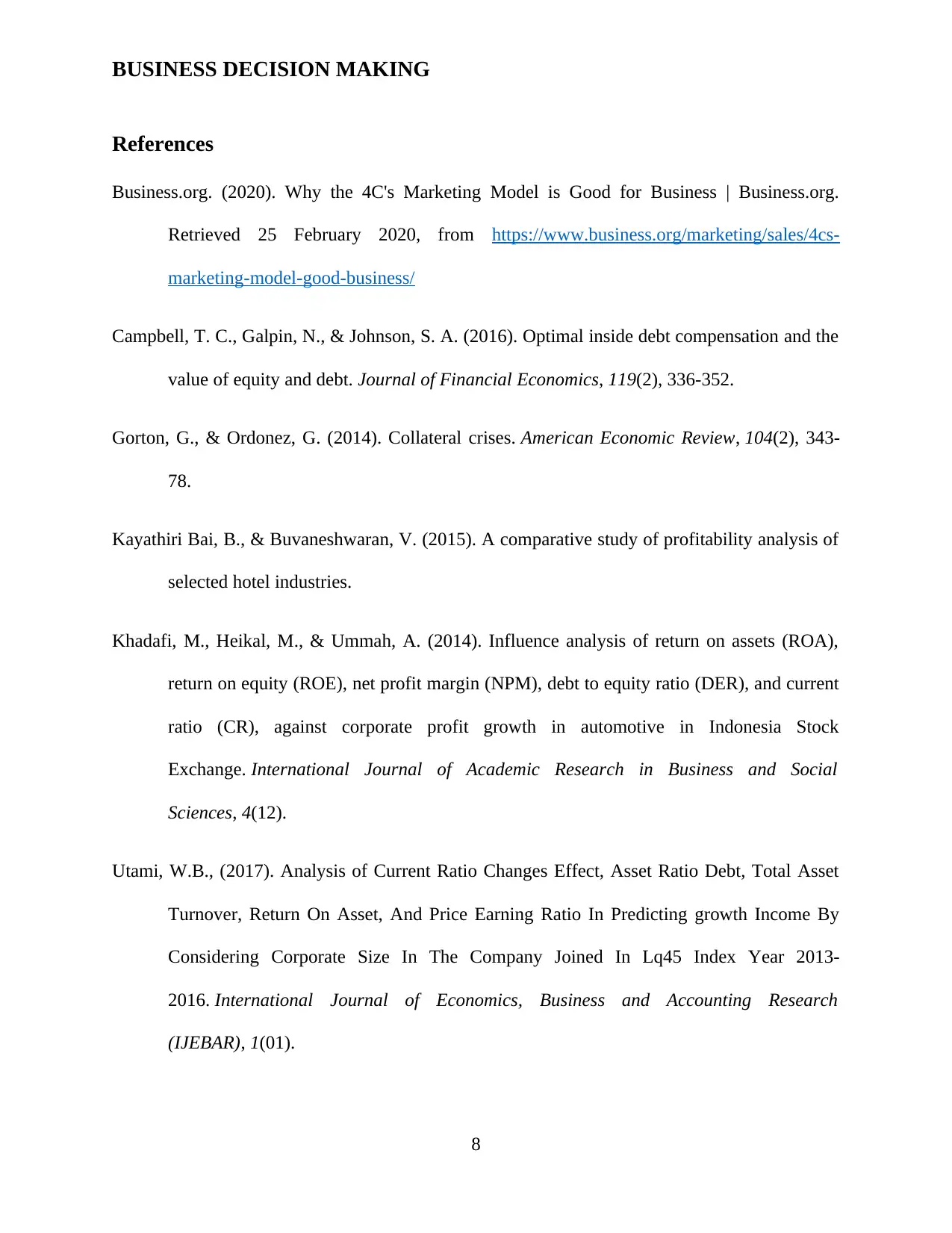
BUSINESS DECISION MAKING
References
Business.org. (2020). Why the 4C's Marketing Model is Good for Business | Business.org.
Retrieved 25 February 2020, from https://www.business.org/marketing/sales/4cs-
marketing-model-good-business/
Campbell, T. C., Galpin, N., & Johnson, S. A. (2016). Optimal inside debt compensation and the
value of equity and debt. Journal of Financial Economics, 119(2), 336-352.
Gorton, G., & Ordonez, G. (2014). Collateral crises. American Economic Review, 104(2), 343-
78.
Kayathiri Bai, B., & Buvaneshwaran, V. (2015). A comparative study of profitability analysis of
selected hotel industries.
Khadafi, M., Heikal, M., & Ummah, A. (2014). Influence analysis of return on assets (ROA),
return on equity (ROE), net profit margin (NPM), debt to equity ratio (DER), and current
ratio (CR), against corporate profit growth in automotive in Indonesia Stock
Exchange. International Journal of Academic Research in Business and Social
Sciences, 4(12).
Utami, W.B., (2017). Analysis of Current Ratio Changes Effect, Asset Ratio Debt, Total Asset
Turnover, Return On Asset, And Price Earning Ratio In Predicting growth Income By
Considering Corporate Size In The Company Joined In Lq45 Index Year 2013-
2016. International Journal of Economics, Business and Accounting Research
(IJEBAR), 1(01).
8
References
Business.org. (2020). Why the 4C's Marketing Model is Good for Business | Business.org.
Retrieved 25 February 2020, from https://www.business.org/marketing/sales/4cs-
marketing-model-good-business/
Campbell, T. C., Galpin, N., & Johnson, S. A. (2016). Optimal inside debt compensation and the
value of equity and debt. Journal of Financial Economics, 119(2), 336-352.
Gorton, G., & Ordonez, G. (2014). Collateral crises. American Economic Review, 104(2), 343-
78.
Kayathiri Bai, B., & Buvaneshwaran, V. (2015). A comparative study of profitability analysis of
selected hotel industries.
Khadafi, M., Heikal, M., & Ummah, A. (2014). Influence analysis of return on assets (ROA),
return on equity (ROE), net profit margin (NPM), debt to equity ratio (DER), and current
ratio (CR), against corporate profit growth in automotive in Indonesia Stock
Exchange. International Journal of Academic Research in Business and Social
Sciences, 4(12).
Utami, W.B., (2017). Analysis of Current Ratio Changes Effect, Asset Ratio Debt, Total Asset
Turnover, Return On Asset, And Price Earning Ratio In Predicting growth Income By
Considering Corporate Size In The Company Joined In Lq45 Index Year 2013-
2016. International Journal of Economics, Business and Accounting Research
(IJEBAR), 1(01).
8
1 out of 9
Your All-in-One AI-Powered Toolkit for Academic Success.
+13062052269
info@desklib.com
Available 24*7 on WhatsApp / Email
![[object Object]](/_next/static/media/star-bottom.7253800d.svg)
Unlock your academic potential
© 2024 | Zucol Services PVT LTD | All rights reserved.